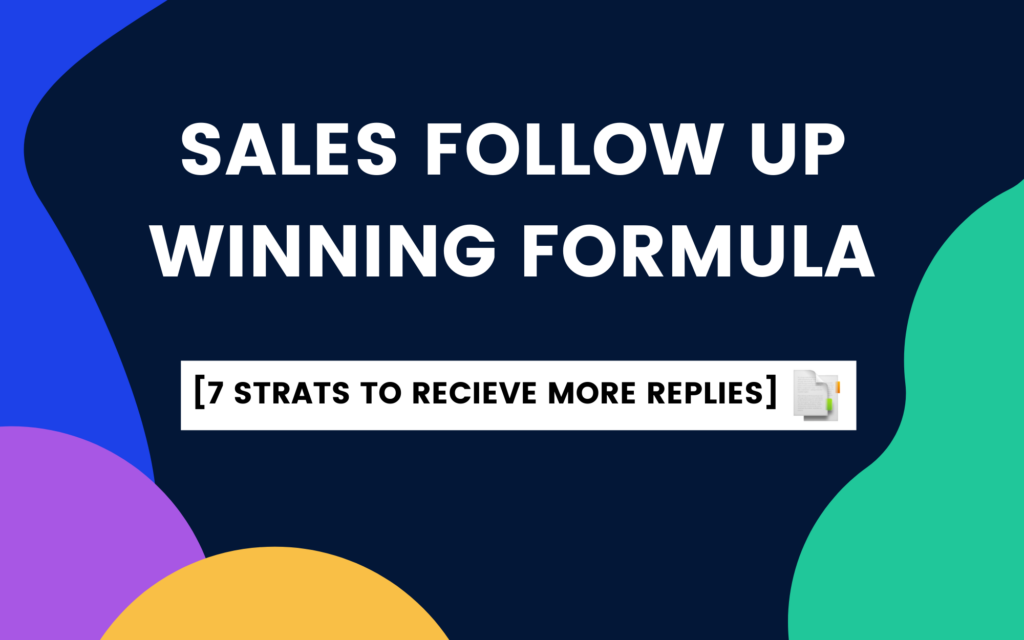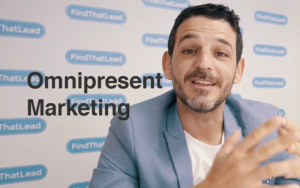Sales follow up are crucial to the success of your sales funnel strategy.
It’s easy to contact someone for the first time -and even to cause a very good first impression.
But if you haven’t expertly crafted your sales follow up strategy, then you’re missing out on the chance to convert a sale.
Considering that email marketing has two times higher returns than calls, crafting great emails is a great way to reach more customers.
However, there is more to following up than simply sending out emails like crazy.
Writing follow up emails is a persuasive art that requires consistency and proven techniques to make it work.
It’s key to be patient enough to don’t overwhelm people, without forgetting persistence to get that answer that you’re looking for.
But how can you implement the best practices to drive a successful campaign?
Although most salespeople will send just one cold email and wait until the potential client answers, there’s more you can do to close a deal.
This article shares the best ways to continue a sales relationship once you’ve made the initial contact.
Following a good communication strategy and these simple but effective follow up strategies and examples, you can reach potential customers and turn them into long-term business relationships.
In this post, we’ll explore:
- How sales follow up emails can help you convert leads into sales.
- How to write a follow up email like a pro.
- Best sales follow up email strategies and tactics.
- Examples of sales follow up subject lines that work.
- Tools for searching for potential customers’ email addresses.
- How to plan an effective sales follow-up schedule.
- Sales follow up process automation.
Why is follow-up important in sales?
The following up is the most important part of the sales process.
It’s not just about getting the deal but building relationships with customers.
And yes, the first contact is crucial.
After all, you only have one shot to cause a great impression to your business’ prospective customers.
But chances are you won’t receive the answers you’re looking for on the very first contact.
When that happens, a lot of people give up because they believe the prospect is just not interested in their services or products at the end.
We all have been there.
And it can be very frustrating.
However, it has been found that most people are simply too busy to respond, or simply not ready to purchase a product or service yet.
Actually, 56% of your market is not currently ready to buy today.
Still, there are opportunities to get noticed and be available when they’re prepared for you.
They might be interested in closing a deal or building a long-term relationship in the future, but you must remember is all about timing.
You’ll need to be persistent and concise on your strategy to close that sale. In the end, sending a well-structured email at the right moment is the most effective sales follow up technique.
Sales follow up statistics
Most salespeople believe that the first contact with a prospect is the most important part of their job.
Indeed, 44% of salespeople stop trying and give up after just one attempt.
They abandon potential customers due to afraid of rejection and lack of confidence.
But guess what? They’re wrong. Indeed, statistics show us you’re missing out on 98% of your sales if you don’t follow up on your contacts.
That means a lot of customers and business relationships you can gain by setting up a solid follow-up campaign.
Furthermore, the probability of closing new sales is higher if you’re persistent.
It’s not enough to just write one email and then wait for them to come back to you.
Moreover, converting leads can take up to five emails. So, the work has only begun with the first contact.
There still are many opportunities to close the deal and acquire a client.
You will need to keep trying until the timing is accurate and your offering catches their attention.
It might take several attempts and require some imagination to figure out the proposal that will impact your prospects.
Besides, it’s also important to focus on the structure and quality of your emails.
Customers and business people won’t react to generic messages.
You need to work on building personalized emails to show them you are genuinely interested in establishing a relationship with them.
These and more custom email strategies that we will cover in this article are the keys to attracting and converting.
How to write a follow up email after no response
You’ve had your first contact, and you’re excited about the possibility of landing this prospect.
You think you did a great job, but now what? The work is far from over.
Now, it’s time to focus on a follow up strategy to catch that lead when the time comes.
But how does the expert do it?
Your strategy for following up with clients and customers might vary depending on the nature of your business or the person you’re contacting.
There are some guidelines, however, that will help you build strong follow up habits that lead to success.
However, you might also be in the process of collecting the emails of businesses or individuals to reach them for the first cold email.
If that’s your case, let me remind you that FindThatLead will allow you to gather target emails directly from their websites and social media.
You can do so by following three simple steps:
- Go to Findthatlead search.
- Provide a list of domains or names from which you want to obtain email addresses.
- Collect the emails and build your campaign.
And as simple as that, you’re now ready to contact them and set up your follow up campaign for those prospects without response.
But if you’re looking for people based on their location, role, or company size, try out the Prospector tool:

Effective sales follow up strategies and tactics
Before sending an email, you need to have a specific objective and motive.
Your objective is what you want to happen—for example, to schedule a call.
On the other hand, your motive is the reason why you’re trying to accomplish this particular action, such as when you’re trying to improve someone’s business website or present a service that will increase productivity in their workflow.
If you already defined your objectives and motives, there are some guidelines you can follow to craft a successful follow up campaign.
- Keep your writing concise.
Be clear and direct about the purpose of your email.
Remember that you’re talking to busy people, and as you didn’t build a solid relationship yet, you must catch their attention within a few lines.
Do not waste people’s time by giving a lengthy explanation about your services or products.
Give the big picture of what you can offer and how it will practically help their business today. You’ll have the chance of giving more details after you get a response!
Besides, it’s important to remember that people often open sales follow-up emails on their mobile devices. Therefore, concise messages have better chances to catch the recipient’s attention until the end.
- Include a call to action.
Some common examples include scheduling a meeting or asking the recipient to read additional information attached to your email.
This way you’ll simplify the process and give another option rather than directly answering your email to schedule a meeting.
For example, you can include a link to your calendar if your objective is to get a meeting.
- Provide value.
Offer free advice or information that can be helpful to them.
This shows that you are willing to help them even if they don’t buy from you (and it makes you more likable).
Besides, it’s your opportunity to show you’re an expert in your field and build a reputation.
You can use this to establish a reputation as an expert in your field by giving a small piece of advice that will lead people back to you if they are interested in hiring your services.
- Use personalization.
Personalize your email by using their name, and mention something that you talked about in previous emails or conversations.
In fact, including the names of prospects in your email campaigns can increase open rates by 29.3%.
It’s a great way to show your potential customers that you truly care about establishing a relationship with them and that you know how to help them.
On the contrary, sending generic sales following up emails can kill your opportunity to reach them.
- Don’t push.
Guilt isn’t a good strategy. You don’t want to make them feel like they are obligated to answer or hire you.
Avoid messages such as “Why aren’t you responding? I already sent several emails without receiving any answer”.
This unprofessional behavior will push them away and make you look desperate.
Professionalism should be above all!
There is nothing worse than a salesperson who is so desperate for a sale that they lower their own integrity and status just to get a lead to buy from them.
- Use a multi-channel approach.
If you already had a conversation with your prospect, but email marketing seems to not be working, it could be time to use a different approach.
Although the main topic of this post is email marketing, diversifying your contact channels is crucial for your sales follow-up cadence.
Think about your buyer persona, and consider trying cold calls or in-person follow up if emails don’t work.
You would be surprised at how often your emails end up in spam, and how often some people tend to ignore this communication channel.
Moreover, you can leverage LinkedIn or another professional network that your potential customer might use to follow up.
- Write well-crafted subject lines.
Follow-up statistics show that 33% of email recipients open emails based on the subject line alone.
Try to entice your readers by using questions, numbers, or humor in your subject lines.
Funny sales follow-up emails could be great icebreakers and make you look like a friendly salesperson without losing professionalism.
Best sales follow up subject line examples
The subject line of your email can make or break your chances of getting a reply.
People receive dozens of emails each day, so it’s easy for yours to get overlooked and forgotten if you don’t make an effort to stand out.
It starts with the way you craft your sales follow-up email subject lines.
To help you get started with your own follow-up emails, we’ve compiled a list of 10 sales follow-up email subject line examples.
10 sales follow up subject lines that convert
- “You are not alone”
You might try exploiting this subject line if you have some exclusive industry research or a killer product that will solve a specific need that you know in advance.
- “[Prospect name], you coming?”
It works because it creates a feeling of fear of missing out. Use it to ask for a meeting or call, after showing the value you have to offer.
- “X options to get started”
You can capitalize on this subject line to offer specific services that address your prospect’s pain points.
- Meeting on [day] at [time]?
When you use this template to create urgency, you boost the chances of receiving a prompt response.
- “Here’s that exclusive info I promised you”
Use this to provide specific information that will help your potential customers. You can catch the attention using a case study or actionable tips that will be valuable for them.
- A 5-step plan to [adress a pain point]
It’s a simple but effective strategy because you are showing how to solve the issue in advance.
- “I’d love your feedback on that meeting”
If you have already met with them, you can ask for their feedback as a way of showing them your commitment to their opinion. This is a great approach to consolidating a relationship that you are currently working on.
- “Our next steps”
It’s your chance to prove that you have a solid business plan that can be valuable for them. You can use this subject line to catch their attention by fueling curiosity.
- “Should I stay or should I go?”
If you have sent some emails without receiving a response, try using a humorous approach in one of your later messages to see if that generates a response.
- “Am I assuming correctly?”
If you haven’t received any responses to your previous emails, this is an opportunity to ask your prospects if you understand their priorities.
Winning sales follow-up process
To ensure that your sales pipeline is full of high-quality leads, it helps to automate follow-up from the very beginning.
At this stage, use FindThatLead to collect information about qualified leads and make outreach attempts.
Automating this process will free you up to focus on the leads that are most likely to convert into a sale.
The next step will be scheduling your follow up strategy to ensure you’re not spamming potential leads with daily emails that go directly to the bin.
Sales follow up schedule
How much follow up is too much?
Although there are no hard rules, you can follow sales best practices to ensure you’re on the right way to close that deal.
At FindThatLead, we wait 3 days before following up on leads.
If there’s no response, we increase the margin between emails to space it out.
The following schedule may help determine when to follow up:
- First email
- First, follow up email (+3 days)
- Second, follow up email (+5 days)
- Third, follow up email (+7 days)
- Four follow up email (+14 days)
- Five follow up email (+30 days)
- Sixth follow up email (+30 days)
- Keep following up once a month
How to automate sales follow up process
FindThatLead offers its customers the option of launching drip campaigns and automatically sending follow up emails when they do not receive a response.
You can leverage this powerful feature to simplify the follow-up schedule and focus on high-quality leads.
The process is quite simple. You can start for free and set up your campaign in just a few steps:
- Go to the Send Emails section in FindThatLead.
- Upload your CSV list with the leads you want to follow up. You can use the Search Tool we introduced earlier in this post to find your targets.
- Write your email using the templates created by the community or build it from scratch.

- Set the delivery time and save your campaign.
Done! your campaign was created successfully.
A final word on how to follow up on a sales lead
Follow up is crucial to the success of any sales campaign, but it’s easy to become bogged down with trying to do too much.
The secret is to keep things simple.
Following up isn’t rocket science, but it can be time-consuming and tedious.
So, developing a solid plan and setting clear goals is an important first step to sales follow-up.
Once you have your plan in place and you’ve identified your goals, you can then figure out what strategy will work best.
By using our sales follow up software solutions, you can easily set up a campaign that converts.
But also, the Prospector and Search tools can easily find the emails for potential clients based on location, industry, job title, and even company size.
Finding and converting leads has never been simpler. All you must do is set up a campaign and personalize your outreach to address your prospects’ specific pain points.
Here, we showed you how to make a sales follow up and provided practical examples for you to craft your next winning email marketing campaign.
Now, it’s your turn to put hands-on work to increase your conversion rate.







 BONUS:
BONUS: The Challenge: Join this free course and I guarantee that after 5 days you will have the necessary skills to start generating B2B clients Growth Hacking and Prospecting techniques.
The Challenge: Join this free course and I guarantee that after 5 days you will have the necessary skills to start generating B2B clients Growth Hacking and Prospecting techniques.